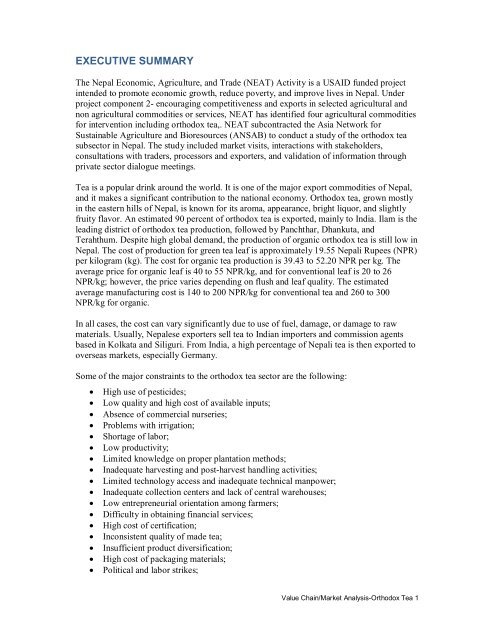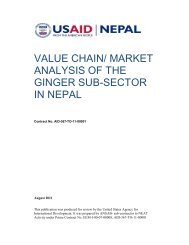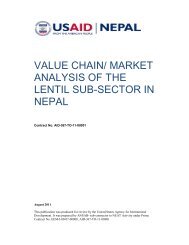value chain/ market analysis of the orthodox tea sub ... - Nepal Trade
value chain/ market analysis of the orthodox tea sub ... - Nepal Trade
value chain/ market analysis of the orthodox tea sub ... - Nepal Trade
You also want an ePaper? Increase the reach of your titles
YUMPU automatically turns print PDFs into web optimized ePapers that Google loves.
EXECUTIVE SUMMARYThe <strong>Nepal</strong> Economic, Agriculture, and <strong>Trade</strong> (NEAT) Activity is a USAID funded projectintended to promote economic growth, reduce poverty, and improve lives in <strong>Nepal</strong>. Underproject component 2- encouraging competitiveness and exports in selected agricultural andnon agricultural commodities or services, NEAT has identified four agricultural commoditiesfor intervention including <strong>orthodox</strong> <strong>tea</strong>,. NEAT <strong>sub</strong>contracted <strong>the</strong> Asia Network forSustainable Agriculture and Bioresources (ANSAB) to conduct a study <strong>of</strong> <strong>the</strong> <strong>orthodox</strong> <strong>tea</strong><strong>sub</strong>sector in <strong>Nepal</strong>. The study included <strong>market</strong> visits, interactions with stakeholders,consultations with traders, processors and exporters, and validation <strong>of</strong> information throughprivate sector dialogue meetings.Tea is a popular drink around <strong>the</strong> world. It is one <strong>of</strong> <strong>the</strong> major export commodities <strong>of</strong> <strong>Nepal</strong>,and it makes a significant contribution to <strong>the</strong> national economy. Orthodox <strong>tea</strong>, grown mostlyin <strong>the</strong> eastern hills <strong>of</strong> <strong>Nepal</strong>, is known for its aroma, appearance, bright liquor, and slightlyfruity flavor. An estimated 90 percent <strong>of</strong> <strong>orthodox</strong> <strong>tea</strong> is exported, mainly to India. Ilam is <strong>the</strong>leading district <strong>of</strong> <strong>orthodox</strong> <strong>tea</strong> production, followed by Panchthar, Dhankuta, andTerahthum. Despite high global demand, <strong>the</strong> production <strong>of</strong> organic <strong>orthodox</strong> <strong>tea</strong> is still low in<strong>Nepal</strong>. The cost <strong>of</strong> production for green <strong>tea</strong> leaf is approximately 19.55 <strong>Nepal</strong>i Rupees (NPR)per kilogram (kg). The cost for organic <strong>tea</strong> production is 39.43 to 52.20 NPR per kg. Theaverage price for organic leaf is 40 to 55 NPR/kg, and for conventional leaf is 20 to 26NPR/kg; however, <strong>the</strong> price varies depending on flush and leaf quality. The estimatedaverage manufacturing cost is 140 to 200 NPR/kg for conventional <strong>tea</strong> and 260 to 300NPR/kg for organic.In all cases, <strong>the</strong> cost can vary significantly due to use <strong>of</strong> fuel, damage, or damage to rawmaterials. Usually, <strong>Nepal</strong>ese exporters sell <strong>tea</strong> to Indian importers and commission agentsbased in Kolkata and Siliguri. From India, a high percentage <strong>of</strong> <strong>Nepal</strong>i <strong>tea</strong> is <strong>the</strong>n exported tooverseas <strong>market</strong>s, especially Germany.Some <strong>of</strong> <strong>the</strong> major constraints to <strong>the</strong> <strong>orthodox</strong> <strong>tea</strong> sector are <strong>the</strong> following:· High use <strong>of</strong> pesticides;· Low quality and high cost <strong>of</strong> available inputs;· Absence <strong>of</strong> commercial nurseries;· Problems with irrigation;· Shortage <strong>of</strong> labor;· Low productivity;· Limited knowledge on proper plantation methods;· Inadequate harvesting and post-harvest handling activities;· Limited technology access and inadequate technical manpower;· Inadequate collection centers and lack <strong>of</strong> central warehouses;· Low entrepreneurial orientation among farmers;· Difficulty in obtaining financial services;· High cost <strong>of</strong> certification;· Inconsistent quality <strong>of</strong> made <strong>tea</strong>;· Insufficient product diversification;· High cost <strong>of</strong> packaging materials;· Political and labor strikes;Value Chain/Market Analysis-Orthodox Tea 1






